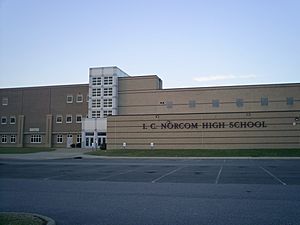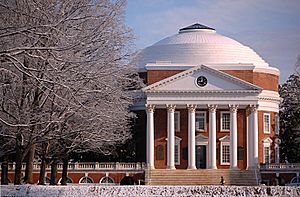Education in Virginia facts for kids
Education in Virginia helps students from pre-kindergarten all the way through adult learning. Virginia's schools are often ranked among the top ten states in the U.S. for education. Students in Virginia usually do better than average in most subjects and grade levels. In 2010, a report called Quality Counts said Virginia's K-12 education was the fourth best in the country.
All schools in Virginia must follow learning rules set by the Virginia Department of Education. These rules are part of a system called the Standards of Learning, which makes sure schools are doing a good job. In 2008, 81% of high school students finished school on time. The Virginia Assembly once said, "Education is the cornerstone upon which Virginia's future rests," meaning education is super important for the state's future.
Contents
History of Education in Virginia
The first free school in America, called the Syms School, started in Virginia in 1635. But people tried to create schools even earlier! In the early 1600s, there were efforts to start schools for Native American children and for white children in the Virginia colony.
Virginia was one of the first colonies to open schools and colleges. For example, The College of William and Mary was founded in 1693.
Later, Thomas Jefferson wanted to create a system of public education for everyone. However, many wealthy landowners at the time did not want to use tax money to educate poor children. Still, Jefferson did start the first public university, The University of Virginia, in 1819.
The first free public school systems in Virginia were finally set up around 1851. Unlike many northern states, public education was not required by Virginia's state constitution until 1870.
Besides free public schools, there were also "pay schools" where parents paid for their children to attend. Before the American Civil War, rich families often hired private teachers. Some schools were funded by parents in a community and were called "field schools" because they were often built in a community field.
After the Civil War, groups like the Peabody Foundation and the Rosenwald Foundation helped build schools, especially for African American students. Church groups also started schools, particularly for Native Americans and communities in the mountains. Today, the Blue Ridge School is one example of a school that started this way.
Virginia built many new schools after World War I and World War II. However, the state had low tax rates, so local school boards often struggled to build enough schools. Over time, spending on schools and teacher salaries increased, and education standards improved.
Today, Virginia has 134 school divisions, which are like local school districts. These are managed by local school boards. About 1,900 schools teach over one million students across the state.
Early Learning Programs
Governor Tim Kaine started a program to use state money for pre-kindergarten education. These programs help young children who might be "at risk" (meaning they face challenges) to do well when they start kindergarten and beyond. In 2008, more money was added to make pre-kindergarten available to more four-year-olds.
K-12 Education
Public K-12 schools in Virginia are usually run by counties and cities, not by the state government. As of 2010, over 1.2 million students were enrolled in about 1,881 local schools. This number includes a few charter schools and special education centers. Between 2000 and 2008, the number of students grew by 5%, and the number of teachers grew by 21%.
Besides regular public schools, Virginia also has special programs for talented students. These include Governor's Schools and selective magnet schools. Governor's Schools are a group of over 40 high schools and summer programs for gifted students. There are also many private schools in Virginia, and about 23,000 students are homeschooled.
Many high schools in the Northern Virginia area are ranked among the top 100 nationwide. For example, Thomas Jefferson High School for Science and Technology is often called one of the best public high schools in the country. Schools in Alexandria and Arlington even pay for students to take college-level tests like Advanced Placement (AP) and International Baccalaureate (IB) exams.
Online Education
Virtual Virginia (VVa) is the state's system for offering online courses to students. These classes are mostly Advanced Placement (AP) courses. They are for students who are homeschooled or attend a public high school where a certain course is not offered. Some courses are also available for middle school students.
These courses are free for students enrolled through a public high school. However, students in private schools, homeschooled students not enrolled through a public school, or those from out of state have to pay. The program started in the 1980s, offering AP courses through satellite to students in rural areas. It has grown into the online program it is today.
VVa currently offers 54 classes, including 23 AP courses and 21 foreign language courses. Most classes last one or two semesters, and a few are offered during the summer. The school uses an online system called Desire2Learn, which lets students access lessons through a web browser.
Standards of Learning (SOLs)
Virginia has a statewide system to support and check its public schools. This system uses strict academic rules called the Standards of Learning (SOLs). Schools measure success through yearly SOL tests and other assessments.
The SOL tests cover English, math, science, and social studies. Students take tests at the end of 3rd, 5th, and 8th grade. They also take tests at the end of some high school courses. English and math are tested in grades 3-8 and in some high school courses. The exact tests depend on the school's curriculum.
When the SOLs were first put in place, some parents felt the goals were too hard. By 2004, students had to take 11 exams based on the SOLs. By 2007, schools needed 70% of their students to pass the SOLs to keep their accreditation (official approval). Some people also argued that the tests did not match what was actually taught in class.
The main goal of the SOLs is to create good schools. They set clear expectations for students, teachers, parents, and colleges. This helps students learn what they need for future education and jobs.
No Child Left Behind Act
The No Child Left Behind Act of 2001 (NCLB) was a big law signed by President George W. Bush in 2002. It aimed to make schools responsible for how well students learned, based on test results. NCLB had four main goals:
- Making schools more accountable for results.
- Giving schools more flexibility and local control.
- Giving parents more choices.
- Focusing on teaching methods that were proven to work.
The goal of NCLB was for all students to be at a "proficient" (skilled) level by the 2012-2013 school year. It also required 95% of eligible students to take the SOL tests. Schools had to meet "Adequate Yearly Progress" (AYP), meaning they had to reach target scores each year. If a school didn't meet AYP for two years in a row, it was labeled as "needing improvement." NCLB also required all teachers to be "highly qualified."
Even though NCLB had good intentions, some people felt it didn't help all students, especially very high-achieving ones. It also put a lot of pressure on teachers to get certain test results. Some argued that NCLB made schools focus too much on tested subjects, leaving less time for important topics like civics. The NCLB law was replaced in 2015 by the Every Student Succeeds Act.
Higher Education
As of 2010, Virginia has 167 colleges and universities. Many Virginia public universities are highly ranked. For example, in 2022-2023, the University of Virginia was ranked 3rd among public colleges in the U.S. The College of William & Mary was 13th, and Virginia Tech was 23rd.
James Madison University has been recognized as a top regional public master's university in the South. Virginia Commonwealth University is known for its fine arts programs. The Virginia Military Institute is the oldest state military college. Liberty University is the largest university in Virginia, with over 92,000 students.
Virginia Tech and Virginia State University are Virginia's "land-grant universities." This means they receive federal funding to do agricultural research and offer helpful services to communities.
Virginia also has 23 community colleges with 40 campuses, serving over 288,000 students. There are also 120 private colleges, such as Washington and Lee University and the University of Richmond.
Virginia law requires public colleges to show their fees separately from tuition. Athletic fees, which help pay for sports teams, have grown in recent years. All students at a university must pay this fee, even if they don't play sports.
| University | Tuition and fees | Athletic fees | % of total |
|---|---|---|---|
| George Mason University | $8,584 | $476 | 5% |
| Old Dominion University | $7,708 | $1,133 | 15% |
| University of Virginia | $10,628 | $657 | 6% |
| Virginia Commonwealth University | $8,817 | $559 | 6% |
| Virginia Tech | $9,589 | $257 | 3% |
| College of William and Mary | $12,188 | $1,422 | 12% |
| Christopher Newport University | $9,250 | $1,147 | 12% |
| James Madison University | $7,860 | $1,114 | 14% |
| Longwood University | $9,855 | $2,022 | 21% |
| University of Mary Washington | $7,862 | $350 | 4% |
| Norfolk State University | $6,227 | $1,441 | 23% |
| Radford University | $7,694 | $1,077 | 14% |
| Virginia Military Institute | $12,328 | $1,362 | 11% |
| Virginia State University | $6,570 | $791 | 12% |
Federal Government's Role in Education
Virginia's two land-grant universities, Virginia Tech and Virginia State University, get money from the federal government. This money helps them do research in agriculture and offer helpful services to communities.
Virginia chose not to participate in some federal education programs. For example, Virginia applied for the first round of federal "Race to the Top" funding, which aimed to improve schools. However, Virginia did not receive funds in that round. In 2010, Governor Bob McDonnell decided that Virginia would not apply for the second round of "Race to the Top" funding. He believed, incorrectly, that the program required states to use common education standards instead of Virginia's own standards.



